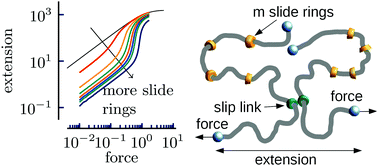Tendomers – force sensitive bis-rotaxanes with jump-like deformation behavior
Abstract
We consider tendomers, which are formed by pairs of rotaxane molecules where each one consists of a linear chain with N Kuhn segments that are threaded through m + 1 small rings. These rings can slide freely along the chains but cannot pass through each other or detach from the chain. By crosslinking the first slide rings of the two rotaxanes a slip-link between the two polymer backbones is formed. The remaining m slide rings form a one-dimensional real gas confined between the slip-link and the other chain end. When pulling the two ends of the chains which are next to the slip-link, an applied external force causes a compression of the slide rings. We consider the exact partition function of this model taking into account the repulsion between the slide rings and the finite extensibility of the polymer chains which is compared with Monte-Carlo simulation data for the tendomer under external force. To understand the underlying physics of the tendomer, we discuss also a simplified thermodynamic approach by taking into account the interplay between chain deformation and compression of the gas of slide rings. We show that tendomers exhibit a jump like mechanical response at a critical pulling force ∝ (m/N)1/2, where the compression of the gas of slide rings sets is. While the tendomer deforms at low forces similar to a short chain of about 2(N − m)/(m + 2) segments, it displays a jump-like decrease in elasticity beyond the critical force and deforms then like a chain of about 2(N − m) segments, before the finite extensibility of the chains sets in. This results in a strong peak of the mechanical susceptibility of the tendomer as a function of the applied force. Thus, tendomers are molecular-elastic elements with a jump-like strain-softening behavior. Our results are generalized to asymmetric tendomers that differ in the number of slide rings per rotaxane, which allows to design multi-step force extension curves with defined critical forces. Finally, we discuss some aspects of gels formed by tendomers, which are promising candidates for tailor-made stress sensitive elastomers.



 Please wait while we load your content...
Please wait while we load your content...